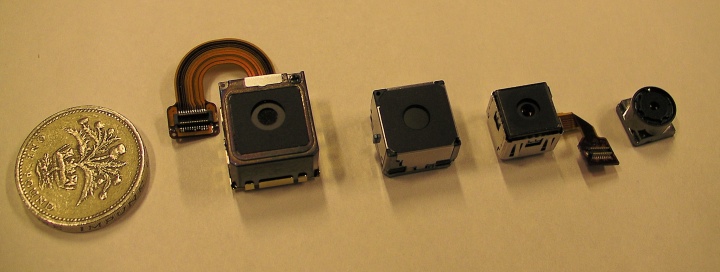Review: Nokia E7, part 1 - Overview and Detailed first impressions
Here I'm reviewing the final retail version of the E7 - the new king of Nokia's Eseries line up. This extensive first review part focuses primarily on the hardware, but it also considers the device's business and multimedia credentials. Future review parts in the coming days from Steve and myself will look at each of these, and other areas in even more detail.
Sections
- Introduction
- In the box
- Design
- Keyboard
- Around the phone
- Size
- Part of a family, differences from the N8, design constraints
- Symbian^3 software
- Ovi Services
- Enterprise capabilities
- Multimedia capabilities
- Initial concluding thoughts
Introduction
The E7's position at the top of the Eseries line up marks it as Nokia's flagship business device. While it may not carry the 'Communicator' label, it is clear that Nokia see the E7 as a continuation of the much-loved landscape QWERTY family. This family originated with the Nokia 9000 (1996) and subsequently moved through the Nokia 9110 (1998), Nokia 9210 (2001, also Nokia's first Symbian device), Nokia 9500 (2004) and, most recently, the Nokia E90 (2007).
The Communicator devices were always marketed as the ultimate mobile business communication tool - and this remains true for the E7. But it is also fair to say that, as the Communicator family has evolved, so too has the mobile world.
The E7 has, necessarily, embraced the trends of multimedia convergence and mobile Internet and consequently has become much more than just a business communication tool. This means that the E7 should really be regarded as a combination of the heritage of the Communicator family and the convergence prowess of the Nseries.
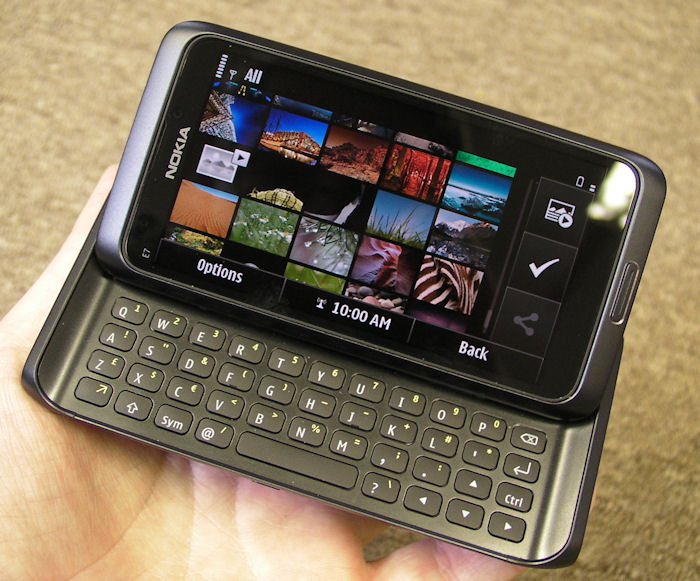
In the box
As part of their ongoing environmental commitments, Nokia has sought to minimise packaging of its products. As a result, the E7 comes in a surprisingly small box - not really hinting at the monster that lurks within.
In addition to the device and the (as expected) slim manual, USB connectivity cables, headset and charger, you'll also find HDMI and USB OTG adapter cables. That's everything you'll need to get the most out of the device, although some may wish to invest in a case to protect their investment.
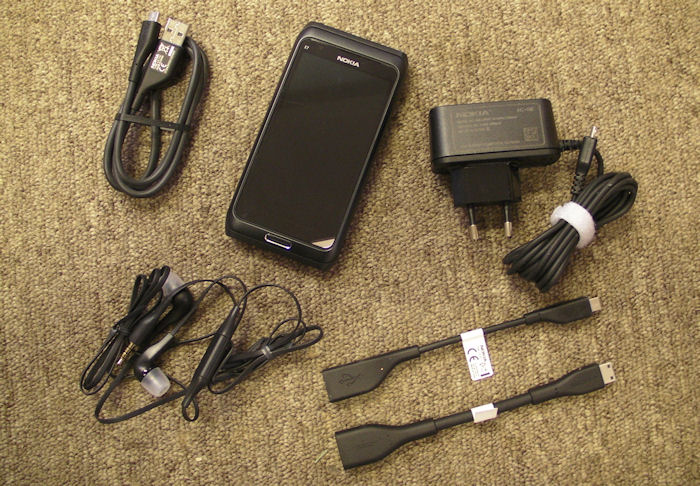
Design
At first glance, the E7 might seem like just another slab smartphone, but the ingenious opening mechanism and accompanying QWERTY keyboard shows that this is very clearly a device with a dual nature. It offers a refreshingly different (form factor) approach in a smartphone market dominated by touchscreen slabs of one variety of another. Being usable in either closed (slab) or open (QWERTY) configurations effectively gives two devices in one package, allowing you to choose the optimal configuration for the task in hand.
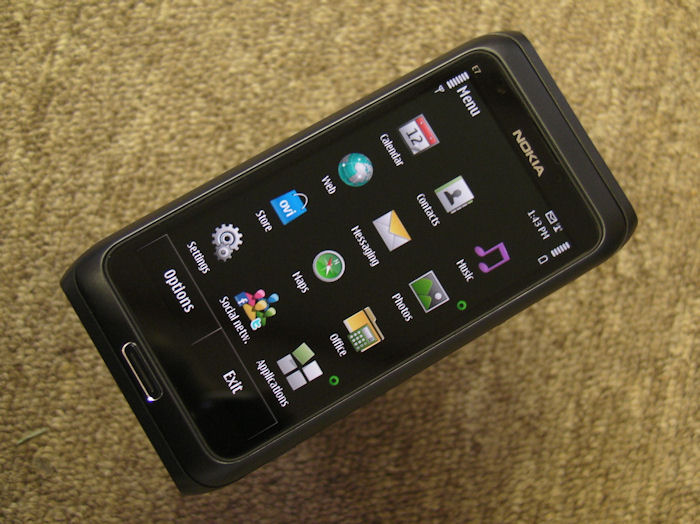
Previous communicators achieved a similar trick by bolting on a phone to the outside of the device. The E7's tilt and slide screen opening mechanism (a refinement of the system used in the N97) is not only more much more elegant, but also more usable.
Typically, devices with complex mechanics and dual usage scenarios compromise on the solidity of the closed configuration. One of the things that impressed me most about the E7 is that those unfamiliar with the device could easily mistake it for an oversized N8. In slab configuration, the device feels rock solid and is well balanced in the hand, with no movement or flex hinting at the presence of an opening mechanism. Revealing the keyboard to an unsuspecting friend for the first time nearly always provokes an exclamation of amazement. Nor are there such compromises in open mode (QWERTY), where the keyboard and screen are equally solid and well balanced.
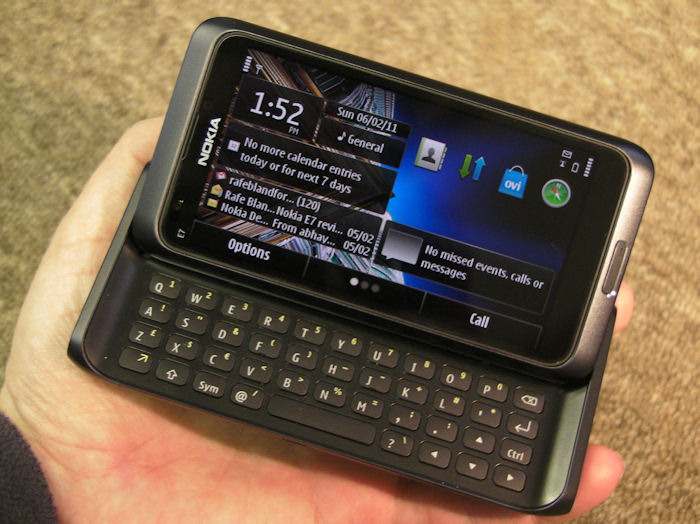
This design quality is a pattern that is repeated throughout the device. The combination of outstanding build quality and premium materials give the E7 a real feel of beauty and luxury. Wrapped in an anodised, scratch resistant, aluminium shell, the E7 is a robust device, which should have no problems surviving every day usage.
In terms of industrial design, given the complex mechanics and the hardware that's been squeezed inside, there's no doubt that the E7 is one of the finest devices Nokia has ever produced.
Keyboard
While on-screen keyboards have come a long way in the last few years, there are always going to be those that prefer physical QWERTY keyboards. It is for people like this that the E7 exists and with the whole device designed around the tilt and slide mechanics there's no doubt that the keyboard is the star of the show.
The keyboard is revealed by having the screen slide up and away into a tilted position at an angle of around 30 degrees. This is achieved by a gentle push on the edge of the screen, after which the screen moves into position with a satisfying clunk. There is a knack to this, with the trick being to let the springs provide most of the force required. Prototype E7 units were rather stiff in this regard, but the retail unit reviewed here is much improved, evidence that design optimisation work continues even after a device has been announced.
At each end of the keyboard, the moulding slopes upwards - a necessity for structural reasons and for the integration of aerials and ports. This gives the appearance of placing the keyboard in a trough, but thanks to generous spacing it's not a problem. The top row of the keyboard, which is closest to the screen, is perhaps a little cramped, but not excessively so. It shouldn't be an issue, aside from for those with very large hands.
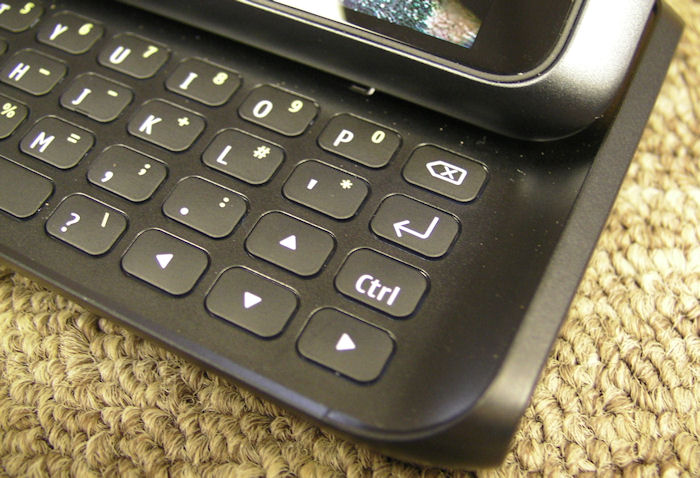
As mentioned, the E7's keyboard is an evolution of that found on the N97 and N97 mini. Because the E7 is a bigger device, there's room for an extra line on the keyboard. Having four lines makes an immediate difference, as the layout is closer to that of traditional desktops and laptops. The most obvious example of this is the return to a central location for the space bar, but other benefits include a standard placement of the comma and full stop punctuation to the right of the m key. Just as importantly, the keys are larger and more widely spaced, making typing for longer periods much more comfortable.
It is abundantly clear that Nokia has devoted a great deal of time and attention to optimising the design of the E7's keyboard. Each key is very slightly domed and has a matt finish (similar to the E72), which gives it a grippy texture. The tactile feedback, with a clear downward motion and 'click' for each key, is much better than a first glance at the flush-chicklet-style key design might suggest. All of these characteristics help improve typing speed and accuracy.
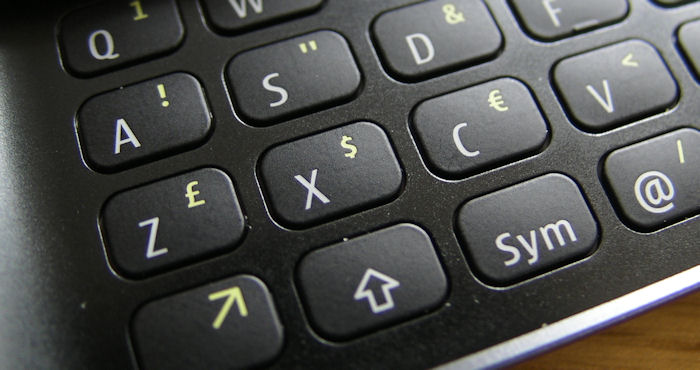
Almost every key has a secondary punctuation or number marking, these are accessed either via the dedicated function key or a long press of the key. The keyboard is backlit, with illumination levels controlled by the ambient light sensor, which means the keyboard only lights up when needed, thus optimising energy consumption.
The inclusion of arrow keys makes general text editing is easier, but they can also be used to navigate around the vast majority of UI elements. You still need to use the softkeys, but that's not an issue as they sit just above the keyboard. Possibly more problematic is the home key, which is located further away in the centre of the right hand end of the screen. This presents a problem if you are using the E7 as it sits on a flat surface (rather than cradled in the hands). You'll need to move a hand away from the keyboard and 'pinch' the home key, because a simple press will just push the E7 across the surface it's sitting on. However, given the home key is really only used when switching tasks, this is not a major concern.
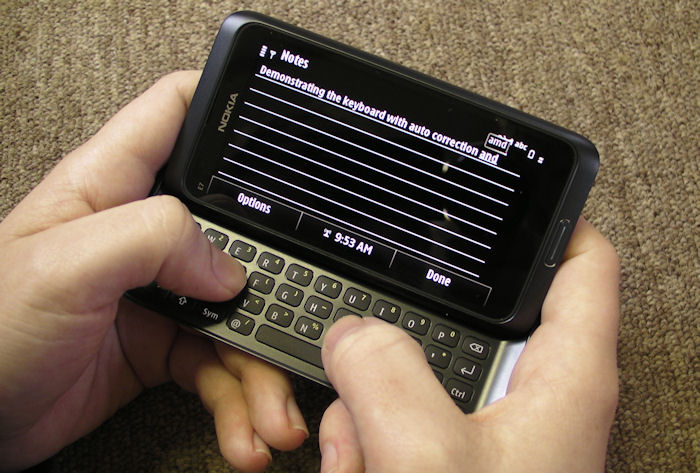
There are two main styles of typing that suit the E7. The first style is holding the device settled in the palm of each hand, with the two thumbs used for typing. Index fingers naturally wrap around the E7 and come to rest on the hinge support (a really clever design touch). The second style is to sit the E7 on a flat surface and use index, middle and ring fingers for typing; those with small hands may be able to use all five digits and touch type. This second style should give faster text entry speeds, especially with practice, but obviously is not something you can do while on the move.
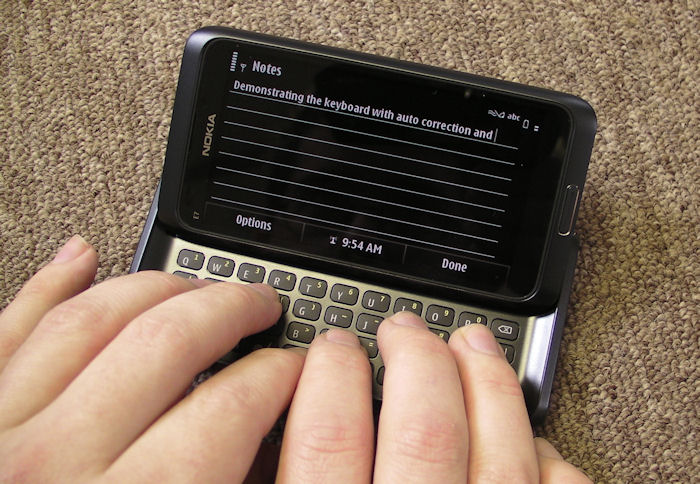
Importantly, even though we're dealing with a physical keyboard, (as shown above) the E7 has optional auto-correction and auto-completion text input settings (the same as those on other Symbian^3 devices). By default these are switched off, but it's well worth trying them out as they can help speed entry and improve accuracy.
Thanks to the good design and generous sizing of the keyboard it should be possible for most people to achieve between 30 and 35 words per minute - most definitely towards the higher end of what's possible on a mobile device.
Assessing keyboards is notoriously subjective; everyone has a different set of criteria and usage scenarios. Moreover it is possible to be fast on almost any keyboard, provided you practice enough. With that said, I would judge the E7 as having the best QWERTY keyboard that Nokia have put on a mobile device. Perhaps just as importantly, it doesn't have a very steep learning curve , which means the majority of people should be pick up an E7 and get up to a decent speed relatively quickly.
Around the phone
Looking around the rest of the device (in closed mode), you'll find the usual Nokia slider lock on the left hand side of the device. It also doubles as the activation mechanism for the E7's LED torch mode (as on the C7 and C6-01). When the homescreen is showing, holding down the slider key for 2 seconds makes the camera LEDs switch on.
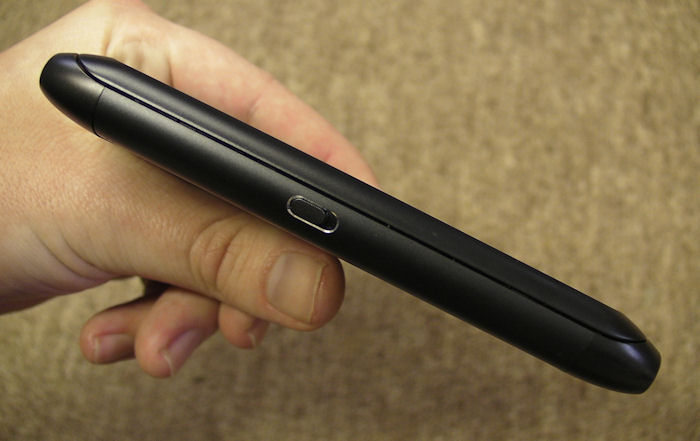
The right hand side of the device houses the camera capture key, volume rocker, and SIM card slot. Both keys are a cut above the norm, another example of the E7's premium design. The SIM card slot houses a removable tray, making it easy to swap SIMs as needed, a notable improvement over the N8's rather recessed slot.
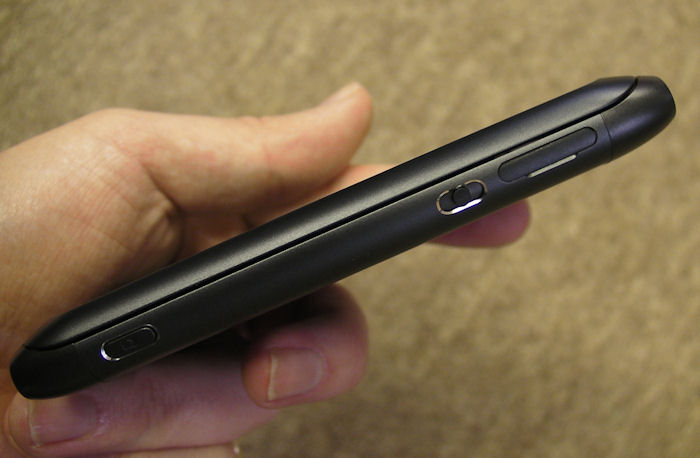
The top of the device houses all the external connectors (mini HDMI out, microUSB and 3.5mm multimedia) and the power button. The microUSB port is used for charging, PC connectivity and USB OTG connectivity. The edge is the most sensible location for these ports and collecting them all in one place means that the rest of the device has smoother lines. In prototype units, the microUSB and HDMI ports were hidden under the same flap, in the retail unit, they are separate and the microUSB port has no cover, which make more sense given it is used for daily charging.
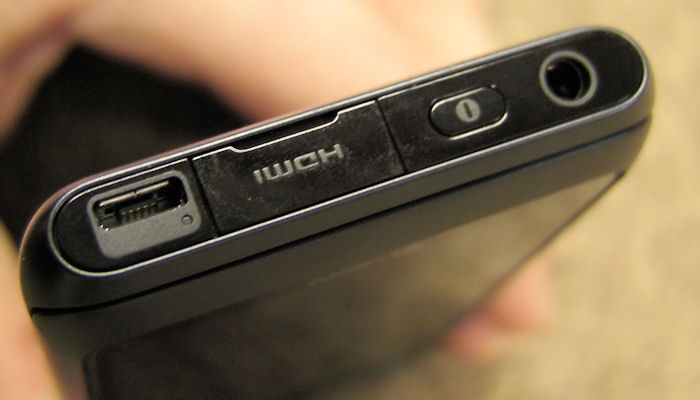
The back of the device houses the 8 megapixel EDoF camera, loudspeaker (upper left) and noise cancelling microphone (lower right). The mono speaker is reasonable, but the placement is not optimal - there' a tendency for it to get muffled when the E7 is sitting on a flat surface (e.g. during speakerphone calls).
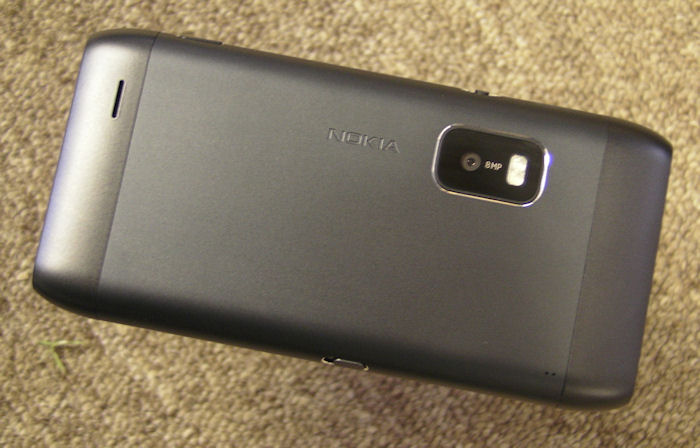
The front of the device is unsurprisingly dominated by the four inch AMOLED screen. After the C6-01, the E7 is the second device with Nokia's new Clear Black Display (CBD) technology. CBD re-arranges the layers in screen matrix to include polarising capabilities and almost completely eliminate reflections (i.e. much improved visibility outdoors) and increase the observed colour vibrancy. The results are extremely impressive, giving the E7 one of the best screens on the market. The screen resolution remains at 360 x 640 (nHD), which is significantly less than some competing devices, but, with the possible exception of web browsing, it does not make that much difference day to day. Thanks to its AMOLED display, the E7 has the same always on clock/date screensaver (when locked) as found on the N8. On the E7, it is turned off by default, but can easily be re-enabled in the Themes settings.
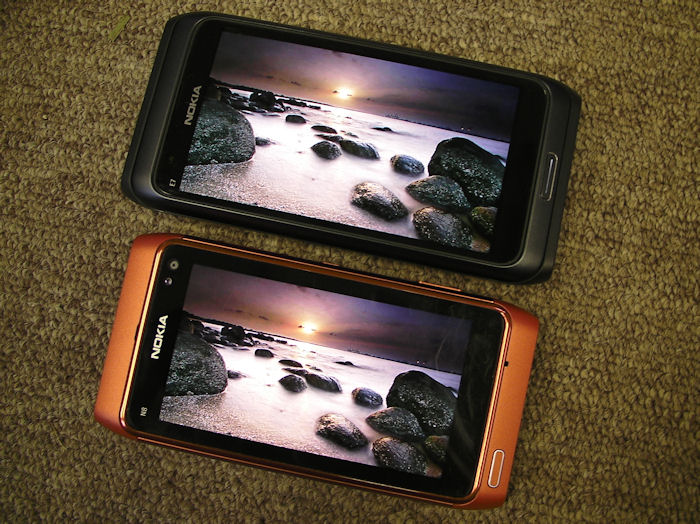
At the bottom of the screen, the home key is placed in the center. This contrasts with earlier devices that offset this key, a holdover from S60's past. A central position is arguably more accessible, is more appealing visually and suits both left and right handers equally. The home key doubles as a notification light, blinking to alert you to new messages and missed calls. Also on the front you'll find the VGA camera for video calling (just right of the Nokia logo) and the ambient light and proximity sensors (just right of the E7 label).
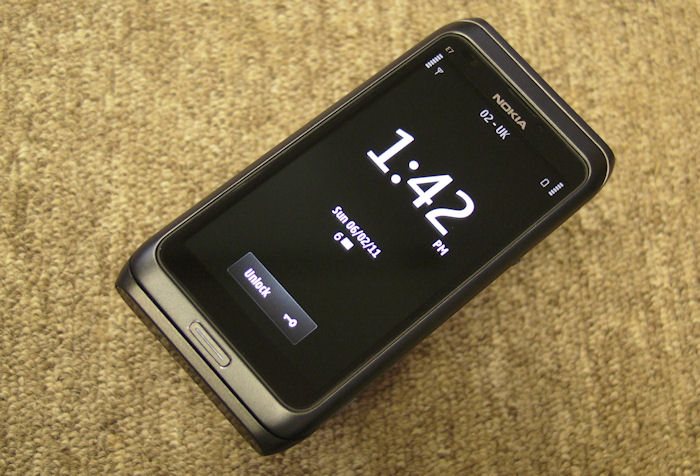
Size
At 123.7 x 62.4 x 13.6 mm, the E7 is wider and longer than any of Nokia's other recent devices, a by-product of using a bigger screen. One handed operation, always an important criteria for mobile usage, is still very much possible, but perhaps a little less comfortable, especially when reaching to the top corners of the screen.
Compared to the N8 (113.5 x 59.1 x 12.9 mm), the E7 is about 10% longer and wider, primarily because it uses a larger screen. However, it is only 0.7mm thicker and that's ignoring the N8's camera hump. When you consider the extra mechanics and space required for the QWERTY keyboard, it is a very impressive achievement. This is further illustrated by the fact that the lower portion of the E7 (i.e. ignoring the upper screen element) is just 9mm thick.
Comparing the E7 with the E90 (132 x 57 x 20 mm) shows just what a difference clever design can make. Again, length and width are largely dictated by the screen, but a drop from 20mm to 12.9mm thickness really underlines the benefits of the tilt-screen design over the clamshell approach.
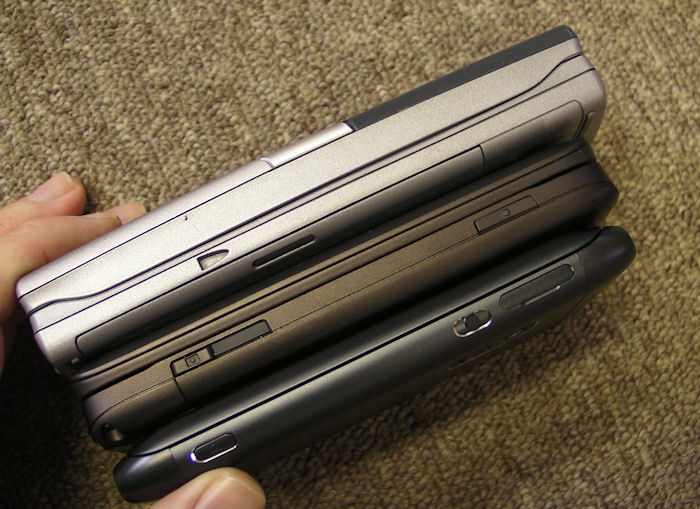
Nokia 9500, E90, E7, from top to bottom. Impressive slimming down from the original 'brick'!
At 176g, the E7 is a heavy phone (41g more than the N8) so it is not going to be pocketable for everyone. However it is a big improvement over the E90 (210g), still less than HTC's competing (and smaller) Desire Z, and the affectionate Communicator nickname 'brick' really doesn't work this time round.
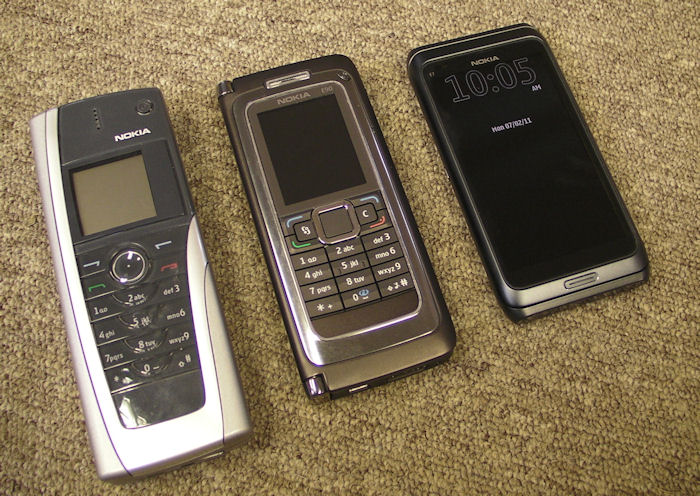
Make no mistake, the E7 is still a big phone, but the size and weight compromise required to get a full landscape QWERTY keyboard is smaller than it has ever been before.
Part of a family, differences from the N8
The E7 is the fourth Symbian^3 device to go on sale, following in the footsteps of the Nokia N8, C7 and C6-01. The devices all share the same basic hardware architecture, with the same processor, graphics acceleration (dedicated GPU co-processor), RAM (256MB), sensors (proximity, ambient light, compass, GPS, accelerometer) and connectivity features (pentaband 3G, WiFI b/g/n, Bluetooth 3.0), which means base performance is very similar. The devices are differentiated through their cost, design, form factor and additional hardware specifications.
The closest relative to the E7 is the N8; the big differences between the devices are the form factor (E7: QWERTY, N8: slab), screen (E7: 4 inch CBD AMOLED, N8: 3.5 inch AMOLED) and camera (E7: 8 megapixel EDoF, N8: 12 megapixel AF and Carl Zeiss Optics). As such, the key choice is between an enterprise centric device or a multimedia centric device. Or, put another way, having a choice between a QWERTY keyboard or superior camera, with size as a possible additional decision factor. However, there are also a number of other smaller differences, which may tip a purchase decision one way or the other.
The E7 omits a microSD card slot, 2mm charging jack and FM transmitter. The 2mm charger is the easiest to ignore; after all, the E7 includes a high powered microUSB charger, which means there is no difference in charging times. The absence of the FM transmitter is a shame, but can, if essential, be replaced by an external unit. The absence of a microSD card slot raises some concerns, but is offset to some extent by the 16GB of internal mass memory and the ability to plug in a USB memory stick (or microSD card in an adapter) via USB On-The-Go.
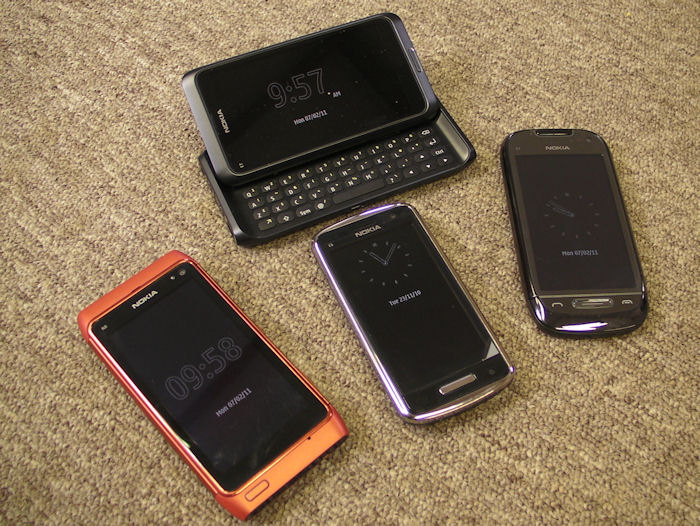
On the plus side, the E7 has 350MB of internal (system disk) memory, compared to the N8's 120MB, which gives more space for core applications and operating system use. It also has a bigger ROM drive (1GB), but that is unlikely to make a difference in the long run. A few additional, enterprise-related, software items are bundled with the E7, which we will discuss in more detail below.
The E7's omissions may seem like Nokia cutting corners or deliberately leaving things out. But, in this, the primary causes are design constraints. While some of these components may seem very small, the tolerances inside the modern smartphone design are extremely small - measured in tenths of a mm, or even less. This means adding or moving a component, even a few mm, can have a major impact and may not be practical. Nor is it enough to fit everything inside a certain area; factors such as aerial placement, structural integrity and performance considerations create very particular restrictions.
For example, a combination of the keyboard mechanics and structural integrity considerations means there is no room along the spine of the device for a microSD card. Similarly, a 2mm charger port takes up a surprising amount of room - as much as 5% of the area on the circuit board. In the case of the absence of the FM transmitter, it's likely to be related to acceptable transmitter placement and performance (the FM transmitter hardware is probably still present).
The same design constraints also explain the E7's downgraded camera. In most phones, the thickness is dictated by the size of the camera module; it's why the N8 has its camera hump. The EDoF camera module in the E7 is significantly smaller than previous equivalents, offering a better size/performance ratio. Without it, the E7 would be a thicker device - an acceptable trade off for some, but, in Nokia's mind, not for the majority. Look for Steve to go into the E7's camera functions in far more detail in the next review part.
The camera modules of the N73, N86, N97 - and the E7
Ultimately, many of the discussions around the E7's hardware are going to focus on such design constraints. Such design decision compromises are an unavoidable part of the modern mobile device, which seeks to pack more into less. There are just too many competing elements and requirements for everyone to be satisfied, which means Nokia has to strike a balance.
So if you're thinking about buying the E7, the question you have to ask yourself is - can I be satisfied with the balance that Nokia has struck? If not, then you need to look at another Symbian^3 device or further afield.
Symbian^3 Software
As with the hardware architecture, so it is with the software. The E7, N8, C7 and C6-01 all share a common version of the Symbian software. While there are a number of minor differences related to differing hardware specifications, Nokia intends to maintain a single code base as far as is possible (a contrast to earlier Nseries and Eseries models) and will update the software for all devices at roughly the same time.
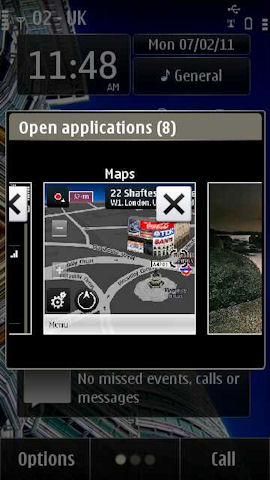
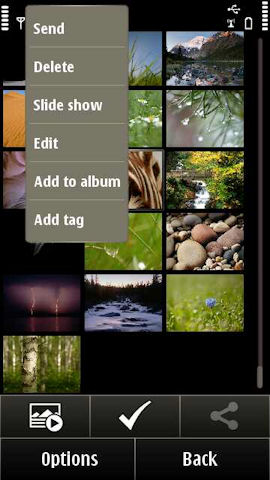
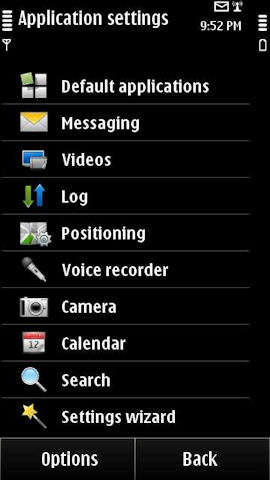
As such, what we said about the software in four of the first five parts (part 1, part 2, part 3, part 4, part 5) of our N8 review can also be applied to the E7. However, the E7 ships with a version of the software (firmware 13.016) that is four months more mature than the original N8's. PR 1.0 on the E7 is equivalent to PR 1.1 on the N8 and C7. This means that the E7 is, by comparison, notably more stable (not a single crash during three intensive days of testing) and has better performance (smoother and faster transitions and UX navigation).
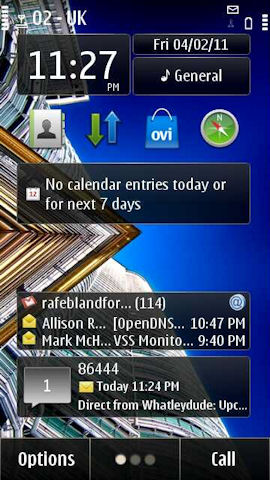
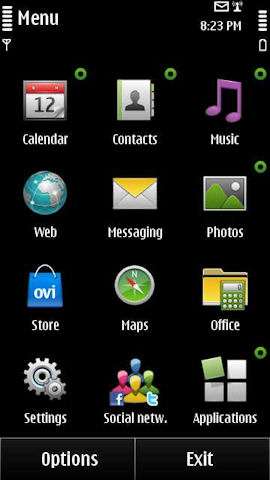
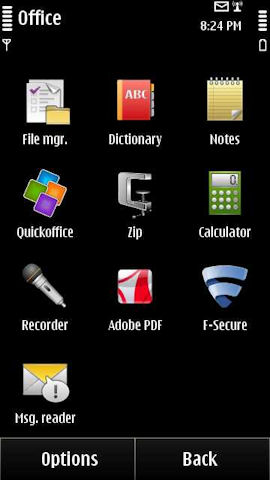
As you'll see from the above screenshots, the retail version of the E7 does have a different look and feel to the earlier Symbian^3 devices, but that's because it ships with a different set of themes, which has a different icon set. Other tweaks include a different third party software bundle (see enterprise section below), extensive help files and a few E7 specific settings, such as slider controls (and associated set up wizard).
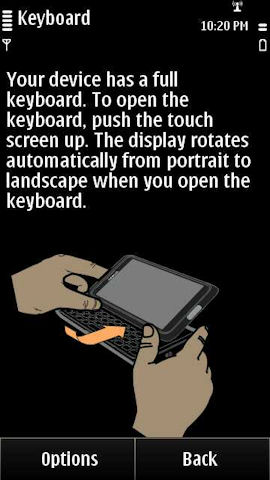
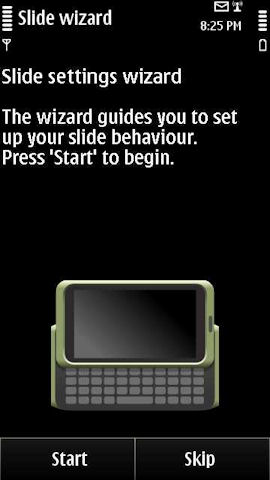
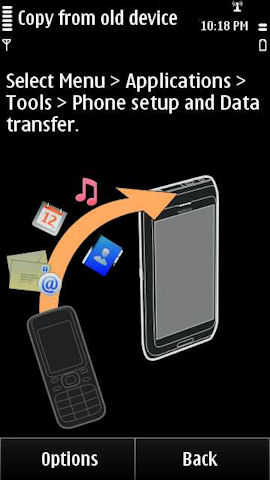
While Symbian^3 is now increasingly familiar, especially to N8, C7 and C6-01 owners, many people looking at the E7 will be coming to it for the first time. It's therefore worth reminding ourselves of some of the key features of the latest version of the Symbian platform: large performance improvements across the board, streamlined UI with an emphasis on direct UI interactions (single tap), intelligent use of screen real estate and finger friendly UI controls, full support for capacitive screens with multi-touch, graphics acceleration giving excellent multimedia and gaming capabilities, and application upgrades and tweaks, including a three page homescreen, new music player and improved versions of Ovi service client applications.
In common with other finger touch driven UIs, the E7's larger screen size, when compared to the other Symbian^3 devices, makes the UI slightly more comfortable to use. Although clearly there's a trade off between physical dimensions and screen size.
The dual nature of the E7 means portrait and landscape usage will both be used frequently. This highlights one of Symbian^3's strengths - every application can be used in both landscape and portrait modes and there is a greater degree of consistency between the two than in competing platforms.


Nokia has faced a lot of criticism for the Symbian^3 user experience (UX). Some of this is fair; the legacy of Series 60 is still present and the web experience, in particular, is out of date. However, much of the criticism that Symbian^3 faces in unfair or ill-informed. Its multimedia capabilities, phone-centric features, energy consumption and resource requirements are all first class. Moreover, the importance of familiarity to the existing user base should not be underestimated; Symbian^3 can quite reasonably be described as a platform that may not acquire new customers for Nokia, but goes a long way to stopping existing customers from departing.
In recent months, Nokia has recognised some of the competitiveness problems of the Symbian^3 UX layer and has said that all devices will receive a program of continuous updates. The E7 will benefit from this just as much as other members of its family. Compared to competing devices, where updates can be more sporadic, this could be an important factor in any purchase decision.
Ovi Services
As with all recent Nokia smartphones, Ovi services provide an important part of the experience. Ovi Maps remains the industry leading crown jewel, but services such as Ovi Music (automatic sign on, carrier billing support, DRM free) and Ovi Store (increasing catalog size, improved client, seamless installations) have also come a long way in the last year.
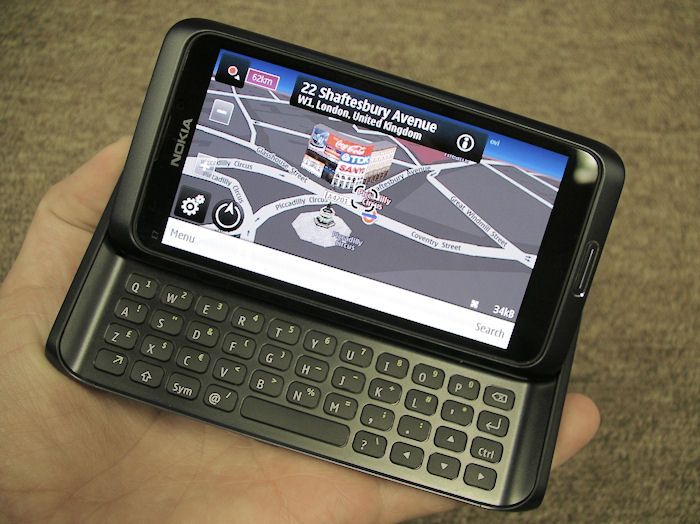
Enterprise capabilities
In keeping with the one platform approach Nokia is taking with Symbian^3, there are no major enterprise software additions to the core platform on the E7. However, the platform itself has some strong enterprise features, which we will cover briefly here, but examine in more detail in a future article.
The Nokia Messaging service is primarily aimed at the consumer market, but may also be applicable in the SME (small-medium enterprise) space. More enterprise friendly is the provision of a Mail for Exchange client, which uses the same mail client as Nokia Messaging. Mail for Exchange has come a long way since its introduction more than five years ago, becoming better featured and more stable. Some limitations remain (e.g. support for only one Exchange account at a time), but it should be more than sufficient for most users. In a similar vein, Lotus Notes Traveler, which should be available for the E7 shortly, provides support for those enterprises using IBM software in their back end.

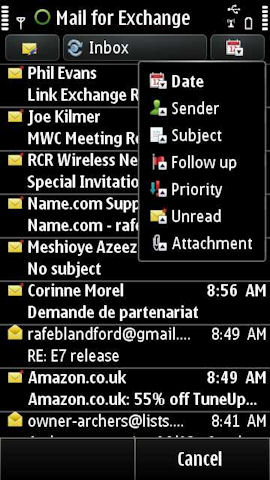
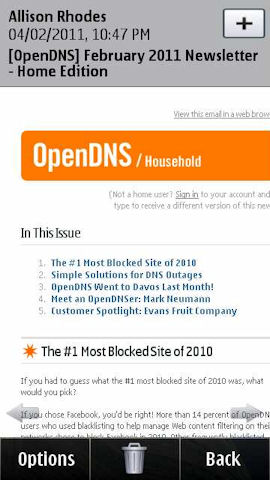
Both Exchange and Lotus Notes are part of a deliberate strategy by Nokia to partner with existing enterprise services to provide Nokia device compatibility. The most obvious example of this is the strategic alliance that was announced with Microsoft last year, which has already provided Office Communicator Mobile (instant messaging) and a web interface for Microsoft Sharepoint (document management) for Nokia devices, with more products and services to come.
A long term strength of the Symbian platform has been its support for VoIP services and the E7 is no exception. After installing the SIP VoIP Settings application, it's possible to set up the E7 with any SIP service. VoIP calling is integrated into the Telephone and Contacts application. As shown in the screenshots here, it's also possible to set VoIP as the default calling type, thus making integration almost completely seamless.
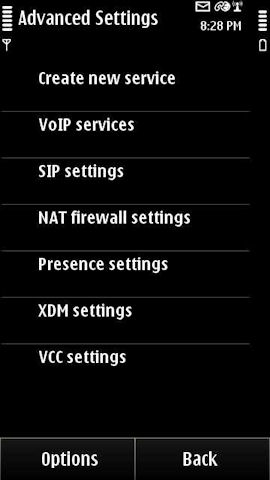
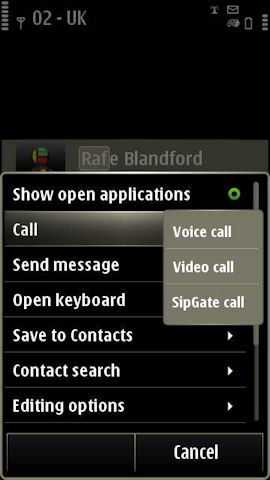
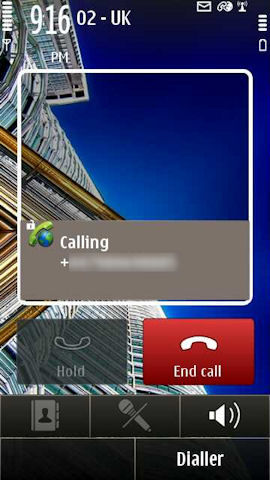
Nokia has also chosen to bundle a number of third party applications. The most significant of these is the inclusion of Quickoffice Premier, with full editing capabilities for Word and Excel documents and PowerPoint presentations viewing capability. In common with the C7 and C6-01, the E7 also ships with F-Secure (security suite, mostly locked, but with free Anti-theft activated), World Traveler (travel utilities), and all Symbian^3 devices ship with Adobe PDF (document viewer), Zip manager (file compression utility) and Dictionary.
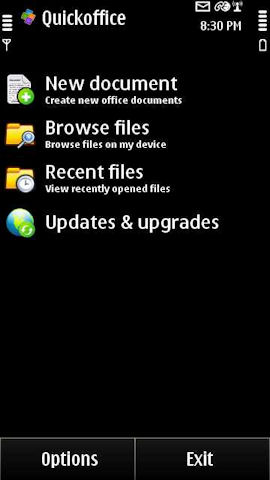
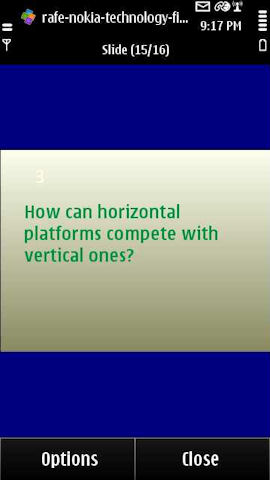
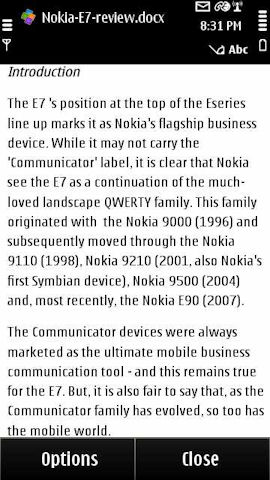
Finally, on a purely cosmetic level, the Office folder, which is usually found within the Applications folder, is promoted to the front application menu (displacing the Videos folder on the N8 etc.)
Taken as a whole, these features provide a decent set of enterprise features. However, there is definitely room for improvements; there's a sense that the out-of-the-box enterprise features have been somewhat eroded from the Communicator days. Third party applications, from the Ovi Store, can fill some, but not all, of the gaps.
What should be attractive to enterprise users is that Nokia provides a diverse range of Enterprise-focussed handsets, of which the E7 is the high-end device. Moreover, Nokia's partnership approach to key services, most notably email, offers an ability to slot into existing infrastructure more seamlessly than some competing products. However, as noted by Wireless Worker, Nokia still has some work to do on the execution of this strategy and needs a better story around deployment and device management for big enterprises.
Multimedia capabilities
Eseries devices have traditionally been a little lacking in the multimedia department. The swish camera-related applications, better video playback support and audio features were left to the 'cooler' Nseries devices. Thanks to the unified hardware and software approach of the Symbian^3 devices, this changes with the Nokia E7. In multimedia terms, camera capabilities aside, the E7 is just as capable as the Nokia N8.
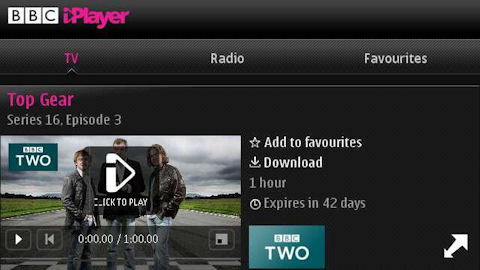
In order to give them the proper attention (and at least pretend to keep this section to a reasonable length), Steve will cover the multimedia capabilities of the E7 more thoroughly in the second part of this review.
Concluding initial thoughts
The Nokia Communicator line always served a role as a provider of flagship devices; intended to be a visible demonstration of Nokia's industry leading technical and design competencies. This still very much applies to the E7; it is packed with technology and is a marvel of industrial design.
The software experience, driven by Symbian^3, may not measure up to quite the same high standards as the hardware, but it is a well known quantity and remains a capable, feature rich and powerful platform. Moreover, the promise of upgrades to come mean that the E7's software is unlikely to stand still.
In a smartphone dominated mobile world, the Nokia E7 may not stand out from the rest of the market as much as the Communicators of old, but it still manages to stand apart and is a compelling device, which will no doubt find may loyal fans.
Rafe Blandford, All About Symbian, 7 February 2011
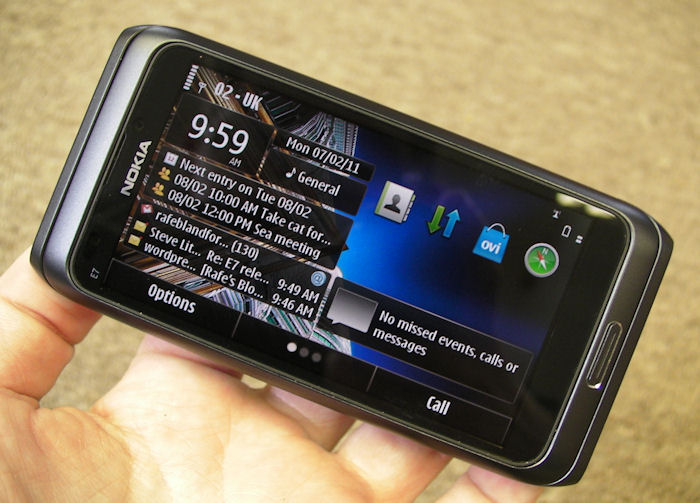
Reviewed by Rafe Blandford at

